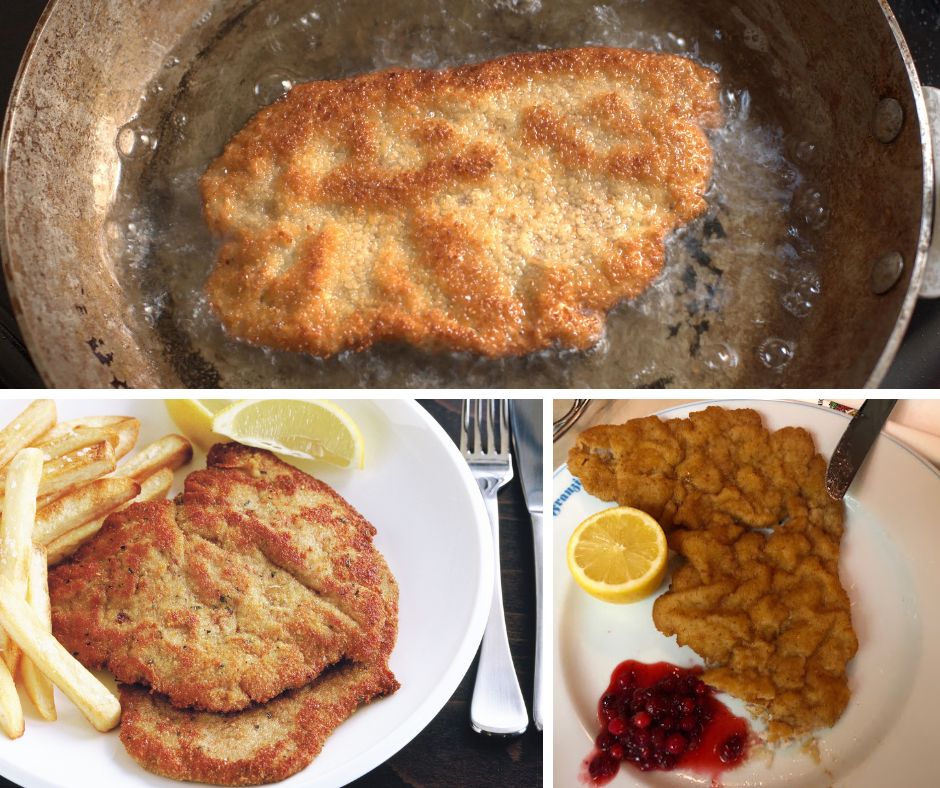Preparation steps:
Start with the thinly pounded veal schnitzels. The thickness of the meat is crucial to achieving the right texture.
Season the schnitzels generously with salt and pepper.
Prepare three separate bowls: one with flour, one with the beaten eggs, and one with breadcrumbs.
Dip each schnitzel first in the flour, then in the beaten eggs, and finally in the breadcrumbs to coat evenly.
Heat the vegetable oil in a pan. Make sure it’s hot enough to form a golden crust, but not so hot that the breading burns.
Fry the breaded schnitzels until golden brown, about 2-3 minutes per side.
Drain the schnitzels on a paper towel to remove excess oil.
Serve the Wiener Schnitzel immediately, garnished with lemon wedges.
Choosing the Meat
Choosing the right meat is crucial for an authentic Wiener Schnitzel. Traditionally, veal is used because of its tender and lean qualities. The meat should be pounded thinly to ensure even cooking and a perfect coating. Austrian cuisine places great emphasis on quality, so it’s advisable to source meat from local farmers or butchers to guarantee its freshness and provenance.
Side Dishes and Serving Suggestions:
The Wiener Schnitzel is a delight on its own, but pairing it with the right side dishes makes the dish even more delicious. In Austria, fried potatoes or potato salad are often served as a side dish. The contrast between the crispy schnitzel and the creamy texture of the side dishes is a culinary experience for the senses.
Another important aspect is the presentation of the dish. Wiener Schnitzel is traditionally served with lemon wedges sprinkled over the freshly roasted meat to add a refreshing acidity. A sprig of fresh parsley serves as a decorative element and adds additional flavor.
A Touch of Tradition:
Preparing Wiener Schnitzel is not only a culinary experience, but also a tribute to Austrian tradition and hospitality. This dish is a staple in family recipes, and the secret of its perfection is passed down from generation to generation.
Preparation steps:
Start with the thinly pounded veal schnitzels. The thickness of the meat is crucial to achieving the right texture.
Season the schnitzels generously with salt and pepper.
Prepare three separate bowls: one with flour, one with the beaten eggs, and one with breadcrumbs.
Dip each schnitzel first in the flour, then in the beaten eggs, and finally in the breadcrumbs to coat evenly.
Heat the vegetable oil in a pan. Make sure it’s hot enough to form a golden crust, but not so hot that the breading burns.
Fry the breaded schnitzels until golden brown, about 2-3 minutes per side.
Drain the schnitzels on a paper towel to remove excess oil.
Serve the Wiener Schnitzel immediately, garnished with lemon wedges.
Choosing the Meat
Choosing the right meat is crucial for an authentic Wiener Schnitzel. Traditionally, veal is used because of its tender and lean qualities. The meat should be pounded thinly to ensure even cooking and a perfect coating. Austrian cuisine places great emphasis on quality, so it’s advisable to source meat from local farmers or butchers to guarantee its freshness and provenance.
Side Dishes and Serving Suggestions:
The Wiener Schnitzel is a delight on its own, but pairing it with the right side dishes makes the dish even more delicious. In Austria, fried potatoes or potato salad are often served as a side dish. The contrast between the crispy schnitzel and the creamy texture of the side dishes is a culinary experience for the senses.
Another important aspect is the presentation of the dish. Wiener Schnitzel is traditionally served with lemon wedges sprinkled over the freshly roasted meat to add a refreshing acidity. A sprig of fresh parsley serves as a decorative element and adds additional flavor.
A Touch of Tradition:
Preparing Wiener Schnitzel is not only a culinary experience, but also a tribute to Austrian tradition and hospitality. This dish is a staple in family recipes, and the secret of its perfection is passed down from generation to generation.

